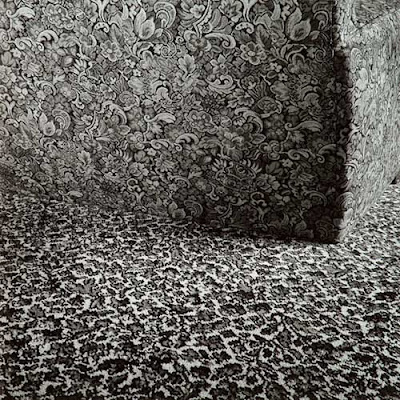From Bonny Dot Cassidy…
There are are exhibitions that come along only once in a curator’s career; and I imagine a survey of Fiona Hall’s work to be one of those — the chance to interact with a living, local artist who has spanned multiple media, who is well-loved and yet surprising and challenging, who straddles cool and classical, and whose art shows a satisfyingly consistent conceptual order. This retrospective’s curatorial triumvirate has treated that task with deserved gravity. The result is a kind of Hall theme park whose only fault is that it dearly wants to occupy the entire Museum or, at least, to converse with other exhibitions in the space.

Fiona Hall, Leura, New South Wales, 1974
Gelatin silver photograph, 28x28cm.
Courtesy of the artist and Roslyn Oxley9 Gallery, Sydney, Australia
© the artist
It’s refreshing that Force Field – at the Museum of Contemporary Art until June 1 – is not chronologically sequenced. Time does not always make the best sense or justice of a career, particularly of an ongoing one. However the thematic design of the show—especially its rather extensive six (!) concept rooms—is unavoidably naff. Hall’s work doesn’t really break up into such neat categories as Consumption, Symbiosis and Trade—surely these constitute a single theme—and this is conceded by the catalogue’s reference to her conceptual preoccupations. In any case, her preference for reiteration results in the scattering of various motifs (brains, mostly vaginal genitalia, woven patterns and surfaces, and vitrine displays) over the six rooms, like spores that have drifted from their source. The affect of their concentrated study upon the viewer is intriguing: I came across one hippie who felt sufficiently softened to stretch prone on a solitary banquette before close-up footage of a munching aphid. Hanging around Hall, people seem to loosen up, spread out, and overuse the word “sensual”—a helpfully clean synonym for sexy, sexual or fecund, which doesn’t accurately describe the nature of Hall’s obsession with the organic. Some of her work is downright filthy, like the hand-painted women cavorting through a surrealist catalogue of coitus in Syntax of flowers. Other pieces are tense, such as her early photographs of adolescent sexuality and physical relaxation, which anticipate Bill Henson’s work—and you wouldn’t find anyone calling Henson “sensual”.
It seems to be a convenient word for a female artist, and one who takes a great interest in craft—the ethos of the handmade and reused. But sensuality disregards the complexity of her work’s impact. Hall gets you in with the woven VHS tape, then knocks you sideways with the vulva. She also manages a disarming combination of rusticity and perfection, like the construction of marine forms from knitted plastic in Dead in the water. The finish of these objects is flawless, and yet their preciousness is undiminished. In ‘Castles in the air of the cave dwellers’, giant fiberglass brains are tumorous with various hive constructions, and nests reappear in Tender. A brilliant arrangement of works means that, as we approach a glass wall of numerals in Tender, we hear the hum of business: a recording of bee drones in the nearby Breeding ground. Indeed, Hall seems to have studied the precision of insects and swallows rather than the mimesis of machines. She is not one for punk ethos; taxonomy and credibility are everything, even when they’re ironic—and they usually are. The daggy, stacked cardboard boxes of Give a dog a bone are home to realist soap carvings of a bone, chicken carcass or crash helmet. This contradiction comes to a fine, thrilling point in Cash crop, perhaps the most stunning piece in the exhibition. Shelved according to size and gently coloured celadon and orange, beige and tan, the flora of trade—from the lemon to the cocoa bean—is labelled with both its common names and correlatives in the idiom of industry. Again, the use of ‘soap’ plays on the word’s mercantile connotations. Some of the labels make delightful visual puns (Insider trading is reserved for the smallest of all, the caper), while others are more oblique.

Kota Ezawa, The Simpson Verdict, 2002.
DVD still, 3-min. loop. Edition of 15
It’s hard to say exactly what would have been the ideal partnering exhibition for Force Field, but I’m unconvinced that the motley selection of works sheltering under the title Southern Exposure: Works from the Collection of the San Diego Museum of Contemporary Art [also until June 1] is it. Diffusing focus upon a single artist by moving us into a group show was probably wise; and relieving our attention to intricacy with big, brash installation and film was obviously considered. Yet I would have preferred, for example, the recent Shahzia Sikander exhibition (housed in the ground floor prior to Hall), to complement Hall, rather than this awkward and discordant selection. On the whole, the San Diego is a rather unenlightening little get-together. I was too excited at the idea of seeing a Chris Burden work to have had any hope of being satisfied by his banal 1979 The Reason for the Neutron Bomb. Lengthy statements accompany both this work and Jeremy Blake’s Winchester painting/film suite. The previous inhabitant of these rooms, Scottish formalist Callum Innes, seemed to have mistaken words for field by theorising on a monitor mounted in the corner of his show; similarly, Burden and Blake need to put words in space that can’t fill itself.
Other pieces in this show have been floating around for a while. Not long ago, I saw Bill Viola’s exquisite Eternal Return in New York, but here it’s unrecognisably diminished. Likewise, I’d encountered the depressing Baldessari in a survey at the impressive Nîmes contemporary art museum. Since, both seem to have been doing the rounds of the globe. But all is not lost: we have Viola’s impending appearance with new work in Sydney to look forward to; and, in this show, we have the inclusion of Kota Ezawa’s The Simpson Verdict, which single-handedly salvages this selection. Ezawa’s digital animation of the OJ Simpson trial is a truly interesting and inexplicably gripping work. A frame-by-frame recreation of the real trial’s camera angles, facial expressions and subtle movements is rendered in simplistic, blockish animation that seems incapable of registering detail. Accompanied by the actual audio of the verdict, however, these childish combinations of colour and shape somehow come to life with great verisimilitude and subtlety.
If it weren’t for The Simpson Verdict, I would deeply resent the separation of the Arnott’s Collection bark paintings They Are Meditating [until August 1] from Hall’s exhibition . Perhaps I do, anyhow. It’s a long bow to draw between twentieth century bark painting from northern Australia and Hall’s response to the wages of white man’s sin; and yet, in the realm of more-than-human life, intricate patterning and readily available materials, it’s a joyously short one. Her work echoes the fine line work in Arnhem artist Yirawala’s x-ray depictions of branching bristles and innards. Bolder are the Groote Eylandt paintings of single insects and marine creatures with thread-like dashes on clean black backgrounds. The highlight of this collection, though, is a series of barks from Port Essington that, like the spectral cousins of the Groote Eylandt works, are each uniquely devoted to a single animal, including emu and turtle. Glowing under spotlights, their ghost smudges are faded, tough white lines that flare and reform. Symbiosis, Trade and Territory could classify this selection, too; but, after levitating to the fourth floor, words of explanation and conceit seem less relevant to the nature and purpose of art-making than ever. We’re not theorising, San Diego, we’re meditating.

